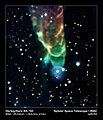Fitxer:Herbig-Haro 49 50.jpg

Fitxer original (2.700 × 3.150 píxels, mida del fitxer: 1,71 Mo, tipus MIME: image/jpeg)
| Aquest fitxer i la informació mostrada a continuació provenen del dipòsit multimèdia lliure Wikimedia Commons. |
Resum
| DescripcióHerbig-Haro 49 50.jpg |
English: This "tornado," designated Herbig-Haro 49/50, is shaped by a cosmic jet packing a powerful punch as it plows through clouds of interstellar gas and dust.
The tornado-like feature is actually a shock front created by a jet of material flowing downward through the field of view. A still-forming star located off the upper edge of the image generates this outflow. The jet slams into neighboring dust clouds at a speed of more than 100 miles per second, heating the dust to incandescence and causing it to glow with infrared light detectable by Spitzer. The triangular shape results from the wake created by the jet's motion, similar to the wake behind a speeding boat. The scientists could only speculate about the source of the spiral appearance. Magnetic fields throughout the region might have shaped the object. Alternatively, the shock might have developed instabilities as it plowed into surrounding material, creating eddies that give the "tornado" its distinctive appearance. Astronomers believe that the blue color at the tornado's tip results from high molecular excitation at the head of the shock. Those high excitation levels generate more short-wavelength emission, shown as blue in this color-coded image. Molecular excitation levels decrease away from the head of the bow shock; therefore the emission is at longer wavelengths, colored red here. The star at the tip of the tornado, which appears to be surrounded by a faint halo, might be a chance superposition along our line of sight. However, the star instead might be physically associated with the tornado. In that case, the halo likely is due to the outflow running into circumstellar material. HH 49/50 is located in the Chamaeleon I star-forming complex, a region containing more than 100 young stars. Most of the new stars are smaller than the sun, although some are more massive. Visible-light observations have found a number of outflows in the region, however most of those outflows have no infrared counterpart. |
| Data | |
| Font | http://www.spitzer.caltech.edu/images/2311-sig06-002-Cosmic-Tornado |
| Autor | NASA/JPL-Caltech/J. Bally (University of Colorado) |
Image use policy: http://www.spitzer.caltech.edu/info/18-Image-Use-Policy
Llicència
| Public domainPublic domainfalsefalse |
| Aquest fitxer és en el domini públic perquè ha estat creat per la NASA. L'avís legal de la NASA diu que «el material de la NASA no està protegit per copyright si no es diu el contrari». (NASA copyright policy page o JPL Image Use Policy). |  | |
 |
Atenció:
|
Llegendes
Elements representats en aquest fitxer
representa l'entitat
12 gen 2006
Historial del fitxer
Cliqueu una data/hora per veure el fitxer tal com era aleshores.
| Data/hora | Miniatura | Dimensions | Usuari/a | Comentari | |
|---|---|---|---|---|---|
| actual | 19:06, 20 juny 2011 |  | 2.700 × 3.150 (1,71 Mo) | Spitzersteph |
Ús del fitxer
La pàgina següent utilitza aquest fitxer:
Ús global del fitxer
Utilització d'aquest fitxer en altres wikis:
- Utilització a ar.wikipedia.org
- Utilització a en.wikipedia.org
Metadades
Aquest fitxer conté informació addicional, probablement afegida per la càmera digital o l'escàner utilitzat per a crear-lo o digitalitzar-lo. Si s'ha modificat posteriorment, alguns detalls poden no reflectir les dades reals del fitxer modificat.
| Títol de la imatge | This "tornado," designated Herbig-Haro 49/50, is shaped by a cosmic jet packing a powerful punch as it plows through clouds of interstellar gas and dust.
The tornado-like feature is actually a shock front created by a jet of material flowing downward through the field of view. A still-forming star located off the upper edge of the image generates this outflow. The jet slams into neighboring dust clouds at a speed of more than 100 miles per second, heating the dust to incandescence and causing it to glow with infrared light detectable by Spitzer. The triangular shape results from the wake created by the jet's motion, similar to the wake behind a speeding boat. The scientists could only speculate about the source of the spiral appearance. Magnetic fields throughout the region might have shaped the object. Alternatively, the shock might have developed instabilities as it plowed into surrounding material, creating eddies that give the "tornado" its distinctive appearance. Astronomers believe that the blue color at the tornado's tip results from high molecular excitation at the head of the shock. Those high excitation levels generate more short-wavelength emission, shown as blue in this color-coded image. Molecular excitation levels decrease away from the head of the bow shock; therefore the emission is at longer wavelengths, colored red here. The star at the tip of the tornado, which appears to be surrounded by a faint halo, might be a chance superposition along our line of sight. However, the star instead might be physically associated with the tornado. In that case, the halo likely is due to the outflow running into circumstellar material. HH 49/50 is located in the Chamaeleon I star-forming complex, a region containing more than 100 young stars. Most of the new stars are smaller than the sun, although some are more massive. Visible-light observations have found a number of outflows in the region, however most of those outflows have no infrared counterpart. |
|---|---|
| Autor | Spitzer Space Telescope |
| Titular dels drets d'autor | http://www.spitzer.caltech.edu/Media/mediaimages/copyright.shtml |
| Amplada | 2.700 px |
| Alçària | 3.150 px |
| Esquema de compressió | LZW |
| Composició dels píxels | RGB |
| Orientació | Normal |
| Nombre de components | 3 |
| Resolució horitzontal | 300 ppp |
| Resolució vertical | 300 ppp |
| Ordenament de dades | a blocs densos (chunky) |
| Programari utilitzat | Adobe Photoshop CS3 Macintosh |
| Data i hora de modificació del fitxer | 14:33, 5 juny 2009 |
| Espai de color | Sense calibrar |

